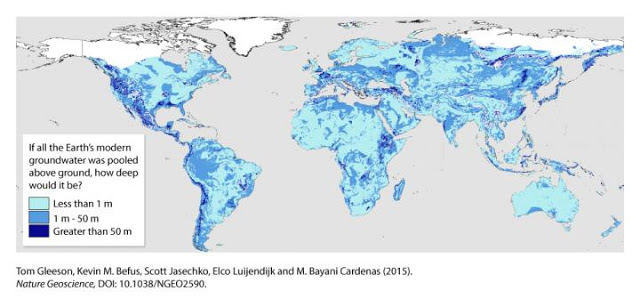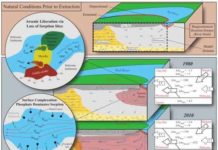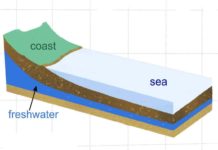
Groundwater: it’s one of the planet’s most exploited, most precious natural resources. It ranges in age from months to millions of years old. Around the world, there’s increasing demand to know how much we have and how long before it’s tapped out.
For the first time since a back-of-the-envelope calculation of the global volume of groundwater was attempted in the 1970s, an international group of hydrologists has produced the first data-driven estimate of the Earth’s total supply of groundwater. The study, led by Dr. Tom Gleeson of the University of Victoria with co-authors at the University of Texas at Austin, the University of Calgary and the University of Göttingen, was published today in Nature Geoscience.
The bigger part of the study is the “modern” groundwater story. The report shows that less than six per cent of groundwater in the upper two kilometres of the Earth’s landmass is renewable within a human lifetime.
“This has never been known before,” says Gleeson. “We already know that water levels in lots of aquifers are dropping. We’re using our groundwater resources too fast–faster than they’re being renewed.”
With the growing global demand for water–especially in light of climate change–this study provides important information to water managers and policy developers as well as scientists from fields such as hydrology, atmospheric science, geochemistry and oceanography to better manage groundwater resources in a sustainable way, he says.
Using multiple datasets (including data from close to a million watersheds), and more than 40,000 groundwater models, the study estimates a total volume of nearly 23 million cubic kilometres of total groundwater of which 0.35 million cubic kilometres is younger than 50 years old.
Why is it important to differentiate old from modern groundwater? Young and old groundwater are fundamentally different in how they interact with the rest of the water and climate cycles. Old groundwater is found deeper and is often used as a water resource for agriculture and industry. Sometimes it contains arsenic or uranium and is often more salty than ocean water. In some areas, the briny water is so old, isolated and stagnant it should be thought of as non-renewable, says Gleeson.
The volume of modern groundwater dwarfs all other components of the active water cycle and is a more renewable resource but, because it’s closer to surface water and is faster-moving than old groundwater, it’s also more vulnerable to climate change and contamination by human activities.
The study’s maps show most modern groundwater in tropical and mountain regions. Some of the largest deposits are in the Amazon Basin, the Congo, Indonesia, and in North and Central America running along the Rockies and the western cordillera to the tip of South America. High northern latitudes are excluded from the data because satellite data doesn’t accurately cover these latitudes. Regardless, this area is largely under permafrost with little groundwater. The least amount of modern groundwater is not surprisingly in more arid regions such as the Sahara.
“Intuitively, we expect drier areas to have less young groundwater and more humid areas to have more, but before this study, all we had was intuition. Now, we have a quantitative estimate that we compared to geochemical observations.” says Dr. Kevin Befus, who conducted the groundwater simulations as part of his doctoral research at the University of Texas and is now a post-doctoral fellow at the United States Geological Survey.
The next step in painting a full picture of how quickly we’re depleting both old and modern groundwater is to analyze volumes of groundwater in relation to how much is being used and depleted.
In a previous study that ultimately led to the investigation of modern groundwater, Gleeson’s 2012 groundwater footprint report in Nature mapped global hot spots of groundwater stress, charting rates of precipitation compared to the rates of use through pumping, mostly for agriculture. Some of these hot spots are northern India and Pakistan, northern China, Iran, Saudi Arabia, and parts of the US and Mexico.
“Since we now know how much groundwater is being depleted and how much there is, we will be able to estimate how long until we run out,” says Gleeson. To do this, he will be leading a further study using a global scale model.
Reference:
Tom Gleeson, Kevin M. Befus, Scott Jasechko, Elco Luijendijk, M. Bayani Cardenas. The global volume and distribution of modern groundwater. Nature Geoscience, 2015; DOI: 10.1038/ngeo2590
Note: The above post is reprinted from materials provided by University of Victoria.










